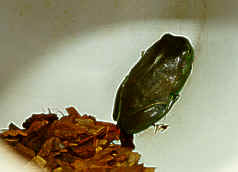Background
information
Australian animals, tree hollows and nestboxes
Australian topics
Nankeen kestrel
Eastern pygmy possum
Green tree frog
Microbats general
Batboxes in
Organ Pipes National Park
Gould's wattled bat
Chocolate wattled bat
Large-footed myotis
Bats, Mosquitoes and Dollars
 |
Frogbox - green tree frog |
|
| Home / Contact us / Product range / Stories / Pest management / Prices |
|
| Green tree frogs, as the name suggests, live in trees, or at least they used to before most of the trees were replaced by downpipes. This little fellow was found in a drum-design owl box in a park about 40m from a designated frog-breeding area. Without any natural hollows in the area, and little litter on the ground, it must have been the best she could find. The box was about 6 metres above the ground. |
|
We have made a few frogboxes as described below, although few have yet been erected and none long enough to prove anything. The boxes are made from a 250mm length of 90mm PVC stormwater pipe mounted vertically. Both ends are capped with standard PVC end fittings; the base glued on and the top pushed on with a smear of Vaseline. The end caps have a raised ridge around the edge so that the lid traps rainwater. A 7mm hole is drilled in the lid to allow the rainwater to run into the pipe. A 7mm overflow hole is drilled in one side so that the pipe holds about 25mm of water. A horizontal entry slot 75mm x 20mm is cut a little way above the overflow hole, at the back of the box. The box is positioned about 65mm out from the tree to allow access to the entry slot. |
|

